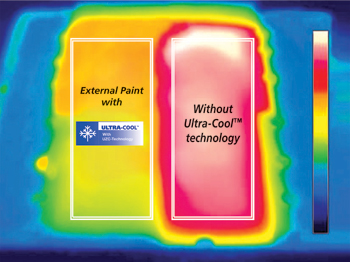Sigma beats heat with Ultra-Cool
01 November 2014
Ultra-Cool is Sigma Paints’ latest technological development especially suited to the Gulf’s scorching heat. The paint, which comes in a wide variety of colour choices, helps keep interiors cooler and cut energy consumption and costs.
Saudi-based Sigma Paints has launched an innovative paint technology that not only promises to keep buildings cool but also bring a wide spectrum of colours within the reach of architects and designers who are involved in creating or renovating the region’s landmarks.
Known as Ultra-Cool with UZC tinting technology, this latest technological development is in line with the paint major’s core values of innovation, dedication and offering durable protection.
“In the harsh hot and dry climate of the Middle East, external coatings are exposed to extremes of temperature and solar heat gain,” says Mohammed Ali Ibrahim, senior product manager of the Dammam-based company. “Solar energy and heat are transferred through the coatings and the building structure, resulting in increased energy requirements to cool the internal living spaces.”
Sigma’s new technology provides a solution to the increasing demand placed on air-conditioning systems and the need to meet regulations on energy-efficient housing, while offering the benefit of a virtually unlimited colour choice, he says.
Ultra-Cool offers energy savings, durability and an unlimited choice of colours allowing even the darkest colours to be used on facades, Ibrahim adds.
The impact of Ultra-Cool paint technology and the energy savings it offers was measured by comparing the surface temperatures of two samples painted in the same colour – one tinted with Ultra-Cool paint technology and the other with standard tinting – when exposed to direct sunlight.
“After one hour of exposure to artificial sunlight, a temperature difference of 20 deg C was found in the two samples. With such a drop in surface temperature, the conduction process is reduced. This leads to a lower air temperature inside the building, reducing the need for air-conditioning and therefore the energy consumption and the impact on environment,” Ibrahim explains.
He elaborates that heat is transmitted from the paint surface to the substrate and the masonry by conduction. Therefore, increasing the reflection of solar energy from the external envelope reduces the internal temperature of the building.
In addition, a lowered paint film temperature also reduces the thermal shock on the coating, making it more durable and increasing the intervals between necessary maintenance.
 |
|
Ultra-Cool ... wide choice of colours. |
In terms of colours, Ibrahim says analysing the TSR (total solar reflection) value of a specific shade can help determine whether it is suitable as a durable and energy-efficient external coating. TSR measures the proportion of solar energy being reflected from the surface. Hence, a high TSR value results in a lower surface temperature. To avoid excess heating of a painted surface, the TSR value should be more than 30 per cent.
He adds that colours with a low TSR value (less than 30 per cent) and high solar absorption coefficient (more than 0.7) will cause overheating of the painted surface and the substrate by induction resulting in high energy costs and less durability.
“Hence, certain colours produced using standard tinting solutions are not recommended for use on external walls due to their high heat-absorbing properties. They raise the temperature of the external walls and reduce the life expectancy of the paint film, resulting in shorter maintenance intervals.
“Any colour with a TSR value below 30 per cent should not be used as a facade coating,” says Ibrahim.
“However, while 25 per cent of the standard colours formulated without UZC technology are not recommended for exteriors, Ultra-Cool, by incorporating this technology, increases the solar reflection of the colours, bringing a spectrum of shades within reach for exterior applications.
“Ultra-Cool paint with UZC tinting technology dramatically increases the TSR value of the colour compared to that produced using standard tinting technology, making many more colours suitable for external use,” he points out.
Ibrahim elaborates: “With Ultra-Cool colour formulation, all colours achieve a TSR value above 30 per cent, therefore, they can all be used externally without any worries of durability and additional heat.
“Studies show that these vibrant colours can improve one’s perception of the living environment. With Ultra-Cool technology, the options are numerous and creativity is no longer restricted by technical constraints. The technology allows home owners and architects to create freely a unique colour scheme.”
Ultra-Cool technology is available for a wide range of Sigma’s exterior products. These include the Sigmacryl range, comprising Sigmacryl Flat, a high-quality flat decorative and protective emulsion type paint, conforming to Saso (Saudi Standards, Metrology and Quality Organisation) standards; Sigmacryl Semi Gloss and Semi Gloss Extra, which are decorative and protective emulsion paints providing a genuine semi-gloss finish; and Sigmacryl High Gloss, a decorative and protective emulsion paint providing a high gloss finish.
The Sigma Guardian range that provides energy savings include Sigma Guardian Nano, a superior quality decorative exterior water-borne protection based on acrylic resins with NPS (nanometric painting system) technology; Sigma Guardian Flex, an elastomeric crack-bridging and anti-carbonation coating for concrete and cement-based substrates, based on pure non-toxic, ultraviolet (UV)-resistant acrylic resins; and Sigma Guardian Coat, based on high quality acrylic resins.
Ultra-Cool in textured finishes include Sigma Profile 4 MM, a high-quality structured medium/course texture finish with ground natural stone, providing high impact resistance; Sigmariver 3 MM, a structured medium-texture finish with ground natural stone, having high impact resistance; and Sigma Textured WR, a weather-resistant finish texture based on copolymer resins, with fine marble aggregates for superior durability.
Link for Temperature of substrate
- Sigma beats heat with Ultra-Cool
- New Dow polymer has cooling effect on roofs
- Hempel unveils ‘The Gem of Paints’ for homes



